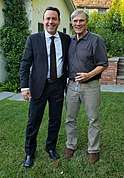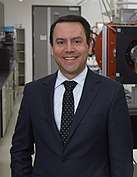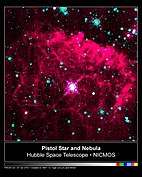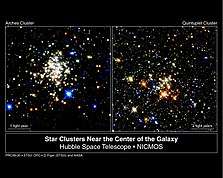Donald Figer
Donald Figer (born 1966) is an American astronomer. He earned his B.A. from Northwestern University with a triple major in Physics, Math, and Astronomy. He received his M.S. in Astronomy and Astrophysics from the University of Chicago. Figer then attended the University of California, Los Angeles (UCLA) for his Ph.D. in Astronomy. After obtaining this Ph.D., Figer continued at UCLA, first as a Postdoctoral Scholar and then as a Research Scientist, during which he served as the Principal Optical Designer and Local Project Scientist for the Near Infrared Spectrograph (NIRSPEC) for the Keck Telescope.[1] It was during this time he identified the Pistol Star as one of the most luminous in the Universe.[2]

Donald Figer | |
|---|---|
 | |
| Born | October 5th, 1966 |
| Education | Northwestern University (BA) University of California (PhD) |
| Children | Chiara Mihi Figer Gemma Nanhi Figer |
| Awards | RIT College of Science Outstanding Outreach Award (2012) NASA JWST Project Team Award (2009) RIT Million Dollar Club (2009) Wickliffe High School Achievement Hall of Fame Inductee (2006) NYSTAR Faculty Development Award (2005) NASA Space Act Award (2004) AURA STScI Technology and Innovation Award (2004) UCLA Distinction in Teaching Award (1995) |
| Scientific career | |
| Institutions | Rochester Institute of Technology (2006-) Space telescope Science Institute (1999-2006) Johns Hopkins University (2000-2004) University of California, Los Angeles (1996-1999) |
| Doctoral advisors | Eric Becklin Ian McLean Mark Morris |

In 1999, Figer joined the Space Telescope Science Institute as an instrument scientist and detector scientist.[1] While there, he claimed 150 solar masses is the upper limit for stars. Using the Hubble Space Telescope, he observed approximately one thousand stars in a young star cluster, the Arches Cluster, which is near the center of the Milky Way. None of the stars surpassed this limit.[3]
Figer would work there until he came to his current place of occupation, Rochester Institute of Technology (RIT). He is a professor in the College of Science and is the director of RIT’s Future Photon Initiative, Center for Detectors, and Rochester Imaging Detector Laboratory. In his time with RIT, Figer has attended, presented at, and hosted a multitude of scientific conferences, most of which concern technologies to improve sensors, discoveries in astronomy and astrophysics, and the researching quantum information science and technology.[4]
References
- http://ridl.cfd.rit.edu/figerastro/CV.pdf
- The Pistol Star. Figer, D.F., Najarro, F., Morris, M.,McLean, I. S., Geballe, T. R., Ghez, A. M., & Langer, N. 1998, ApJ, 506, 384
- An Upper Limit to the Masses of Stars. Figer, D. F. 2005, Nature, Vol. 34, No. 7030, 192
- https://www.rit.edu/directory/dffpci-don-figer
External links
- Hubble shows stars have weight limit (NPR interview)
- USA Today article
- Future Photon Initiative
- Center for Detectors
- Donald Figer's personal webpage
